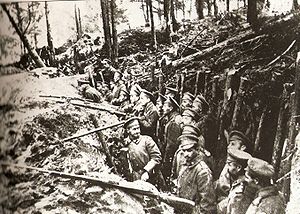
Back معركة ساريقاميش Arabic Sarıqamış döyüşü Azerbaijani ساریقمیش دؤیوشو AZB Сарыкамышская бітва Byelorussian Битка за Саръкамъш Bulgarian Batalla de Sarighamish Catalan Bitva u Sarikamiše Czech Schlacht von Sarıkamış German Herekatê Sarıqamışi DIQ Μάχη του Σαρίκαμις Greek
| Battle of Sarikamish Сражение при Сарыкамыше-Srazhenie pri Sarykamyshe Sarıkamış Muharebesi Սարիկամիշի Ճակատամարտ | |||||||||
|---|---|---|---|---|---|---|---|---|---|
| Part of the Caucasus campaign of the Middle Eastern theatre in World War I | |||||||||
 Russian trenches in the forests of Sarikamish | |||||||||
| |||||||||
| Belligerents | |||||||||
|
Supported by: | |||||||||
| Commanders and leaders | |||||||||
|
|
| ||||||||
| Units involved | |||||||||
| 3rd Army | ||||||||
| Strength | |||||||||
| 78,000[2] |
Turkish estimate: 100,000[3][4] Russian estimate: 90,000[5] to 150,000[6] people and 244 guns in battle 190,000 people and 300 guns in total[7] | ||||||||
| Casualties and losses | |||||||||
|
Russo-English sources: 20,000–28,000[8][9][a] killed, wounded, and frostbitten |
Turkish-German sources: 60,000[10]–78,000[11] killed, wounded, frostbitten, and captured[5] Russian–French sources: 90,000 casualties[6][12] including: 28,000 KIA and 18,000 POWs[b] | ||||||||
The Battle of Sarikamish[c] was an engagement between the Russian and Ottoman empires during World War I. It took place from December 22, 1914, to January 17, 1915, as part of the Caucasus campaign.
The battle resulted in a Russian victory. The Ottomans employed a strategy which demanded highly mobile troops, capable of arriving at specified objectives at precise times. This approach was based both on German and Napoleonic tactics. The Ottoman troops, ill-prepared for winter conditions, suffered major casualties in the Allahuekber Mountains. Around 25,000 Ottoman soldiers froze to death before the start of the battle.[9]
After the battle, Ottoman Minister of War Enver Pasha, who had planned the Ottoman strategy in Sarikamish, blamed his defeat on the Armenians, and the battle served as a prelude to the Armenian genocide.[15][16]
Some sources estimate the significance of the battle as one of the most important in the company, as a result of which the 3rd army was so defeated that it was forced to stop fighting for a while.[17]
- ^ Spencer Tucker, The Great War, 1914-1918, (University College London Press, 1998), p.178
- ^ Cite error: The named reference
Muratoff252was invoked but never defined (see the help page). - ^ Aydın, Nurhan (2015). Sarikamish Operation (in Turkish). p. 40.
- ^ Cite error: The named reference
Ozdemir444was invoked but never defined (see the help page). - ^ a b c "САРЫКАМЫШСКАЯ ОПЕРАЦИЯ 1914–15 • Great Russian Encyclopedia – Electronic version". old.bigenc.ru. 2017. Retrieved 13 March 2024.
- ^ a b Maslovsky 1933, p. 133.
- ^ Oleynikov 2016, p. 84.
- ^ Muratoff, Paul; Allen, W. E. D. (1953). Caucasian Battlefields... p. 284.
- ^ a b Joshua A. Sanborn. Imperial Apocalypse: The Great War and the Destruction of the Russian Empire. Oxford University Press. 2014. P. 88
- ^ Çakmak, Fevzi (1935). Operations on the Eastern Front in the First World War (in Turkish). pp. 73–74.
- ^ Sander, Liman von (1927) [1919]. Five Years in Turkey. Annapolis, Maryland: The United States Naval Constitute. ISBN 978-1-78149-197-3.
- ^ Commandant M. Larcher. La guerre turque dans la guerre mondiale. P. 389.
- ^ Неприятельские потери на нашем южном и юго-западном фронтах//Нива.1915.номер 10
- ^ Oleynikov 2016, pp. 250–251.
- ^ Balakian, Peter (2003). The Burning Tigris: The Armenian Genocide and America's Response. New York: HarperCollins. p. 178. ISBN 0-06-019840-0.
- ^ Suny, Ronald Grigor (2015). "They Can Live in the Desert but Nowhere Else": A History of the Armenian Genocide. Princeton University Press. p. 243. ISBN 978-1-4008-6558-1.
- ^ Oleynikov 2016, pp. 84–85.
Cite error: There are <ref group=lower-alpha> tags or {{efn}} templates on this page, but the references will not show without a {{reflist|group=lower-alpha}} template or {{notelist}} template (see the help page).